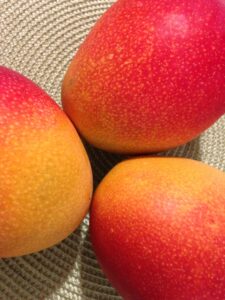Mexican fruit is delicious. Mexico is a fruit-growing country although the fruits will vary based on whereabouts you are since the areas are very diverse.
Mexico has a variety of fruits, some of which are cultivated on trees and others on the ground. A lot of them taste distinctly tropical. Although produced in Mexico, several of these fruits of Mexico are actually native to other nations.
Table of Contents
Mexican Fruit: Mango
Worldwide, particularly in Mexico, mangoes are incredibly popular. One of the leading fruit growers is Mexico. They’re said to have Asian ancestry. On trees, mangoes can be found in full bloom. When ripe, they offer a gorgeous sweetness.
Mexican mangoes are rich in minerals and vitamins, and consumed alone or combined with other foods like fruit salads and chutneys. They may also be turned into juice, glaze, purée, and preserves, as well as dried chunks. You’ll often find them on a Mexican fruit stand and their sticky sweetness makes them very hard to resist.
Mexican Fruit: Papaya (Pawpaw)
Papayas are also popular in Mexico where it’s believed they originated. A papaya tree has the potential to reach a height of 12 feet. Additionally, papayas cultivated in Hawaii are reputed to have a sweeter flavor than papayas grown in Mexico.
The flavor of a ripe papaya is sweet and juicy. It is nourishing to the digestive system and rich in vitamins and fiber. It is possible to eat the fruit’s seeds as well. Their flavor is comparable to black pepper.
When discussing herbal medicine, papaya is also a factor. It makes claims of having laxative, antimicrobial, and other beneficial characteristics.
Mexican Fruit: Pineapple
When it comes to pineapple production, Mexico is one of the leading nations. Bananas are the most popular tropical fruit, with pineapples coming in second. I love this Mexican fruit with Tajín (a wonderful mixture of chile powder, salt and lime).
A mature pineapple takes 18 months to develop from a seed. Because the fruit does not become much sweeter after being plucked and softens while it ripens, it must be picked at the proper time. This is one of my favorite types of Mexican fruit.
Pineapples include a variety of vitamins, minerals, fiber, and digestive-friendly enzymes. It is a pleasant and nutritious fruit. According to experts, pineapples contain micronutrients that help prevent blood clots and protect against cancer.
Additionally, the heart is supposed to benefit from this Mexican fruit. Additionally, it is said that pineapple juice stimulates the kidneys and aids in the removal of toxins from our systems.
Mexican Fruit: Avocado (Yes They’re a Fruit!)
Although they are sometimes included in recipes with vegetables, avocados are botanically a fruit. In Mexico and Central America, they are a natural crop. They develop on tropical tree branches and are very beneficial to your health.
They include a ton of antioxidants, vitamins, and minerals. The humble avocado is an essential fruit for everyone, including infants and young children. Avocados may be used in a variety of ways, including in salads, dips, and more. You can even make avocado ice cream.
Mexican fruits are flavorful and nutritious. In America, you may find them in supermarkets and food markets. Are oranges and bananas becoming boring to you? Want some fresh fruit in your life? Purchase a couple to taste if you’ve never had these Mexican fruits before. Verify the fruit’s ripeness and savior the fresh tastes!
One of the finest areas to find the sweetest, tastiest fruits in season is Mexico. There are several unusual fruits that are accessible in Mexico that you’ve probably never heard of, despite the fact that you could believe you’ve tasted them all.
Try looking for them at the farmer’s market or local Mexican grocery. Or if you’re on vacation in Mexico, you will find these wonderful sweet treats everywhere. You’ll be astounded by the variety of tastes and textures in Mexican fruits! I’m often looking for Mexican fruit cups near me, for the flavor as well as the nutrition of course.
Mexican Fruit: Sapote (Zapote)
Sapote de Yellow is a fruit that is indigenous to Mexico and Central America. Black, yellow, white, and chicozapote are the most popular colors. The form and flesh will differ depending on the type, but both have a sweet taste and are tender.
How To Eat It
How do you eat this tasty Mexican fruit? Remove the seeds, peel the skin, and scoop out the flesh using a spoon before cutting the zapote in half to consume. It may be enjoyed raw or added to dishes like this smoothies with bananas and zapote, ice cream, fresh fruit drinks, cakes, breads, and marmalades.
Mexican Fruit: Mamey
This brown Mexican fruit is a kind of zapote that originated in Mexico, Costa Rica, and Cuba but is now widespread in Latin America. Some consider mamey the best Mexican food.
It has an oval form and a tough brown skin, yet its soft, vivid orange meat flesh is visible through the skin. The flavor has been compared by some to pumpkin pie. It combines apricot and pumpkin flavors with nutmeg and vanilla undertones.
How to Eat It
Split the fruit in half, take out the seeds, and use a spoon to scoop out the flesh. Although it tastes fantastic in ice cream and dessert recipes, it may also be consumed raw.
Mexican Fruit: Cherimoya
Cherimoya is a tropical and native Mexican fruit with a very sweet taste. It’s a tropical fruit that is indigenous to Colombia, Ecuador, and Peru too. It has an oval form, green skin, and prominent indentations that give it a faint dragon egg-like appearance.
Its flesh is milky white, silky, sweet, and has a flavor that is a cross between pineapple, banana, and papaya. Cherimoya custard with sweet taste is especially well-loved by anyone who enjoys this delicious fruit from Mexico.
How to Eat It
Remove the seeds before cutting it in half to consume. Chilling chirimoyas in the refrigerator before cutting them open and eating the flesh with a spoon like custard is one of the greatest ways to consume them. Additionally delicious are beverages, salads, and treats like this pistachio-and-chirimoya custard.
Mexican Fruit: Naranjilla (Lulo)
This is a tropical fruit that originated in South America but is now common in southern Mexico. It is a spherical, orange-yellow fruit with green flesh that resembles tomato flesh.
Its sweet and slightly tangy juice makes it very valuable. It may be consumed raw or cooked, and it’s frequently employed in the preparation of pies, jellies, jams, beverages, ice cream, and even wine through the fermentation process.
Squeeze the flesh from the apple by cutting it in half. The cooling naranjilla drink or lulada made from sweet naranjilla juice is ideal for beating the summer heat.
Mexican Fruit: Tuna (Prickly Pear)
Don’t let the name confuse you – there’s nothing fishy about this Mexican exotic fruit! Prickly pear fruit is indigenous to Mexico and South America but is also found in France, Italy, Spain, Portugal, Egypt, and several other countries in the Middle East. It is renowned for its hard, prickly exterior and tender, sweet, and watery inside.
Although there are numerous types, green, red, yellow, brown, and pink are the most well-known. Pear, cucumber, watermelon, and pineapple are the main flavors the prickly pear offers.
How to Eat It
To prepare them, make a ¼-inch deep cut lengthwise and remove the fruit’s two ends with a paring knife. Simply draw back with your finger while holding the outer layer in place between the flesh and the skin.
Now you know about the most popular fruit in Mexico, you might like to try some of the above ideas out. Add some freshness, color and nutrients to your plate.




